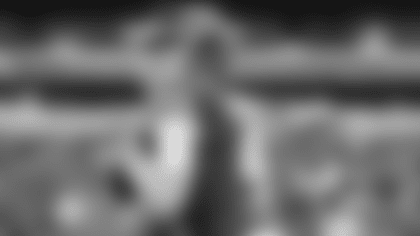*This is the fifth in a series of stories reviewing the Jets' 2007 season and previewing 2008, position by position: *
When Shaun Ellis heard that the Jets had acquired NT Kris Jenkins in a trade from the Carolina Panthers, the veteran defensive end stopped for a moment.
"I was like whoa," he said. "We've got a huge body. Kris Jenkins moves well. For a big man, he runs good for his size. He's probably one of the best defensive tackles at the point of attack. So it was a great addition."
At 6'4", 349 pounds, Jenkins will man the A-gap between the center and the guard. He'll require double-team attention as Ellis works the gaps inside and outside the RT and Kenyon Coleman mans the gaps inside and outside of the LT.
"Look at some 3-4 defenses out there," Ellis said. "In San Diego, they've got Jamal Williams [6'3", 348], who's big and stout. Look back and Buffalo was great when they had Ted Washington [6'5", 375]. In New England, they've got Vince [Wilfork, 6'2", 325].
"The middle is the nucleus of the 3-4. You have to have somebody who's big in the middle and can hold the A-gap. You have to."
The Jets front office had similar thoughts when presented with the opportunity to get Jenkins and determined it was a trade it had to make. That pickup made Dewayne Robertson expendable and the Green & White shipped the 6'1", 310-pounder to the Broncos last Thursday.
Last season, Ellis said the D-line "played in spurts." He thought the unit held up well at the point but wasn't as consistent as it was in 2006 and got beat on some things, including cutback lanes. Coleman, in his first season with the Jets, had 90 tackles (53 solo), Robertson pitched in with 74 tackles and four sacks, and Ellis quietly tied for the team lead with five sacks, led the club with 12 QB hurries and added 60 stops.
"The 3-4 is more of a team defense. Everybody has to work with each other and you have to have gap control," Ellis said. "The 3-4 means you're two-gapping so you have B and C and the nose gap over A. The linebackers have their gaps also."
The 4-3 is based on the notion of attacking and allows players to rack up stats. For a defensive lineman, the 3-4 means a lot of dirty work: occupy blockers and many times allow someone behind you to make the play.
"In the 4-3, you just stay on your side and press your gap down. As a defensive end in the 4-3, all you have is the outside contain," Ellis said. "You can chase everything down when the ball goes away from you."
"But when the ball goes away from you in a 3-4, you have to maintain gap integrity in the B-gap and let the A-gap control it," he added. "You have to play responsible. It's not like you can run behind the blocks."
And why is gap integrity so important?
"You must read all your keys first before you just fly off to the ball," Ellis said. "And if you get turned out of your gap, that's a big old hole."
The Jets were also bolstered up front by reserve contributions from DTs CJ Mosley, who played in a career-high 14 games and had 2.5 sacks, and Sione Pouha, who signed a contract extension this off-season. And DE Mike DeVito, a Maine product, appeared in seven games after becoming the only undrafted rookie free agent to make the Jets' 53-man roster for the season opener.
For the second consecutive season, the Green & White played much better defense down the stretch. The coaching staff got creative in the second half and the 6'5", 285-pound Ellis was even used at linebacker.
"It was something I wasn't used to. I had fun with it," he said. "You get to see the game from kind of a different perspective back there. It was pretty fun, but I'm a lineman and I'd rather be down."
Ellis is a mauler, though, and has made a good living in the trenches, so the position switch won't ever be permanent.
"It felt really weird. I had never done it during my whole career. Standing up, you see a lot better," he said. "But the contact itself is kind of delayed, so you can react quickly, I guess, but I like contact."
The Green & White also confused offenses with their cloud formations at the line of scrimmage. They would stand up defensive linemen and linebackers alike, overload one side and then send players all over the place. Ellis or another lineman may have lined up on right and then sprinted left at the snap of the ball, a player who started in the middle could go right, etc.
"It puts the most pressure on the center because the center calls out the checks," Ellis said. "It really screws guys' gaps. They'd tried to counter with quick snaps and screens . It's not a type of play you can run on every down. I think every time we ran it, we had success with it."
Success with every defense starts up front. Ellis, the fourth-leading sack artist in Jets history, and Coleman will now line up adjacent to one of the game's bigger NTs in Jenkins. But the primary goal will remain the same: contain the run (the Jets were 29th in the league last season at 134.8 yards per game) and then work from there.
"It all depends on the run," Ellis says. "If you can make teams one-dimensional where they have to pass, your sack numbers go up. If you can't stop the run, then they'll continue to run the ball on you."













